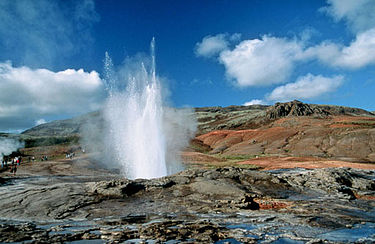The Similarity Between Musical Fountains and Geysers: Nature Meets Art
At first glance, musical fountains and geysers may seem like entirely different phenomena—one a man-made entertainment spectacle and the other a powerful natural occurrence. However, a closer look reveals surprising similarities between these two captivating displays of water in motion. Both fascinate onlookers with their dynamic bursts of water shooting into the air, and each, in its own way, represents the interplay of water, pressure, and energy. Let’s explore how musical fountains and geysers share common ground in both form and function.
- Water in Motion: The Core Attraction
The most obvious similarity between a musical fountain and a geyser is the dramatic upward movement of water. In both cases, water is propelled high into the air, creating impressive, sometimes awe-inspiring displays.
Musical fountains use pumps and engineering to shoot water into the air in precise patterns, often timed to music, creating artistic and fluid displays.
Geysers, on the other hand, are a natural occurrence caused by geothermal activity. Water trapped beneath the Earth’s surface is heated until it becomes pressurized and then bursts out through vents, creating a spectacular eruption.
In both instances, the movement of water draws people in and inspires wonder, whether it’s the meticulously controlled artistry of a fountain or the raw, untamed force of a geyser.
- Power Behind the Performance
Both musical fountains and geysers rely on the release of built-up energy to create their displays, though the source of this energy differs significantly.
Musical fountains are powered by mechanical pumps, often aided by computer-controlled systems that manage water pressure, timing, and lighting. The energy is derived from electricity, which powers the pumps to push water upward in beautiful patterns. Some fountains are even solar-powered, making them an eco-friendly marvel.
Geysers are powered by geothermal heat. Water that seeps into underground reservoirs is heated by volcanic activity, turning it into steam. This steam builds up pressure, and when it becomes too great, it forces water and steam up through the geyser’s vent in a dramatic eruption.
In both cases, the sudden release of energy creates a striking visual spectacle, whether in the controlled elegance of a musical fountain or the raw force of a natural geyser.
- Timed Intervals and Unpredictability
Interestingly, both musical fountains and geysers can operate on a cycle or at timed intervals, but there’s a key difference in predictability.
Musical fountains are designed to follow exact patterns and schedules, offering choreographed performances that are predictable and repeatable. These shows are carefully timed, with water jets rising and falling to the beat of music, creating an orchestrated dance of water.
Geysers, while less predictable, can still have regular intervals. Some geysers, like the famous Old Faithful in Yellowstone National Park, are known for erupting at relatively predictable times, though the exact timing and height of each eruption can vary depending on underground conditions.
Despite the differences in control, both musical fountains and geysers captivate audiences as they wait in anticipation for the next burst of water to shoot into the air.
- Visual Spectacle: Lights vs. Nature’s Colors
One of the most striking elements of a musical fountain is its integration with lighting, which can change the entire appearance of the fountain. These colored lights are synchronized with the water movements, creating a visually stunning spectacle that enhances the performance.
Musical fountains are often equipped with multicolored LED lights that illuminate the water, adding to the drama of the display. These lights can change colors to match the mood of the music, making the fountain a multi-sensory experience.
Geysers, while lacking artificial lighting, often create their own natural visual spectacle. The sight of water exploding from the earth, accompanied by clouds of steam and mist, is striking against the backdrop of a clear blue sky, a sunset, or a moonlit night. The surrounding environment, whether it’s rocky terrain, colorful mineral deposits, or vibrant plant life, adds to the beauty of the natural display.
In both cases, the combination of water and light—whether natural or artificial—creates a breathtaking visual experience.
- Cultural and Natural Significance
Both musical fountains and geysers hold significance in their respective realms, attracting attention and inspiring awe.
Musical fountains are often seen as works of art, blending engineering, design, and entertainment. These fountains are frequently the centerpiece of public squares, parks, or attractions, drawing crowds who come to enjoy the artistry and the spectacle. Iconic examples include the Dubai Fountain, the Bellagio Fountains in Las Vegas, and the Buckingham Fountain in Chicago.
Geysers, in contrast, hold a special place in nature. They are rare and valuable features of geothermal areas, and many are protected in national parks and nature reserves. Geysers like Old Faithful have become symbols of the raw power of the Earth and are popular destinations for tourists seeking to experience the wonders of nature.
Both have become important attractions in their own right, whether man-made or natural, offering a window into the beauty and force of water in motion.
Conclusion
While musical fountains and geysers originate from entirely different sources—one being a product of human creativity and engineering, the other a natural wonder—they share many similarities. Both captivate with their displays of water shooting high into the air, relying on the build-up and release of energy to create their performances. Whether it’s the precise choreography of a musical fountain or the unpredictable power of a geyser, these water spectacles remind us of the beauty and drama that water can bring to both the natural and man-made world.
Ultimately, both geysers and musical fountains offer moments of awe and wonder, reminding us of the power and artistry that water holds, whether shaped by nature or human hands.

